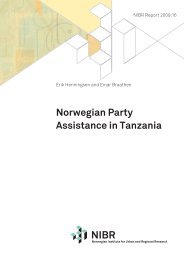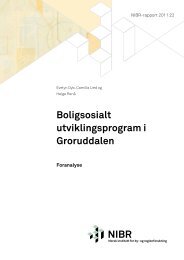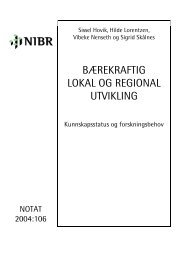http://www.tandfonline.com/page/terms-andconditions
The special importance of housing policy for ethnic minorities ...
The special importance of housing policy for ethnic minorities ...
- No tags were found...
Create successful ePaper yourself
Turn your PDF publications into a flip-book with our unique Google optimized e-Paper software.
6 H. Skifter Andersen et al.Table 1. Immigrants living in four Nordic countries and the proportion of them <strong>com</strong>ing from EasternEurope and Non-European countries.Denmark Finland Norway SwedenProportion of population born outside the 9.8 4.4 10.8 14.3country,%Immigrants from Eastern Europe,% 0.8 1.7 1.8 3.2Immigrants from non-Europeancountries,%4.5 1.5 5.0 6.2Source: Anderson et al. 2010.Downloaded by [Norsk Institutt for By og] at 07:07 11 March 2013as shown in Table 1. Finland has received much fewer immigrants than the other countries,while the share of immigrants in Sweden is about 40% higher than in Denmark and Norway.Moreover, the ethnic <strong>com</strong>position of immigrants varies between the countries. Mostimmigrants to Finland <strong>com</strong>e from Eastern Europe, especially Russia. Finland has relativelyfew immigrants from countries outside Europe, <strong>com</strong>pared with the other three countries,in which a total of 5% of the whole population are immigrants who originate from outsideEurope. Norway, Finland and Sweden also have many immigrants from Eastern Europe.Housing policies in the four Nordic countriesThe function of the housing markets is out<strong>com</strong>e result of policies influencing housingconditions. The important issue in this article is whether housing policy has a differentimpact on the housing of the immigrant population than that of the majority population.In the following sections we will present major traits of housing policies and housingmarkets in the four Nordic countries to explain immigrants’ position and segmentation inthe housing market. There is not the space for a detailed description in this article, but amore thorough description can be found in Skifter Andersen (2012).Housing policy can be defined as public initiatives that affect the supply, price andquality of dwellings, as well as how they are distributed among households. Housing policyis to some extent intertwined with urban policy, which influences where and how dwellingsare located and the qualities of neighbourhoods.Some general features of housing policies can be indicated that are important forimmigrants. As stated above, immigrants’ housing options are very dependent on the generaloptions on the housing market for low-in<strong>com</strong>e groups, and the ethnic segmentation of themarket depends much on the degree of in<strong>com</strong>e segmentation. This segmentation dependson the extent that housing policy creates equal opportunities and economic incentives indifferent tenures. If housing subsidies or tax incentives are designed in such a way thathigh-in<strong>com</strong>e groups receive the largest support in owner-occupation and only low-in<strong>com</strong>egroups are supported in rental housing, it can be expected that there will be pronouncedin<strong>com</strong>e segmentation. Yet, if housing policy is more universalistic, in the sense that it isto a greater extent aimed at housing for the whole population and not only for vulnerablelow-in<strong>com</strong>e groups, in<strong>com</strong>e segmentation will be lower.Another important feature is whether housing policy makes the market more, or less,transparent. Complicated systems of economic support and rules for access to housingmake it more difficult for immigrants, with limited knowledge of the housing systems, toidentify good housing options. Connected to this is whether conditions for discriminationare enhanced. If rules for access to rental dwellings are unclear, or if allocation is entrustedto landlords alone, the risk of discrimination is greater.
















